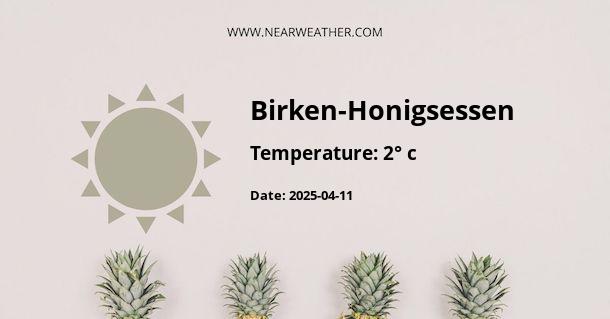Understanding the Climate and Weather of Birken-Honigsessen, Germany
In the heart of Germany, nestled in the state of Rhineland-Palatinate, lies the small village of Birken-Honigsessen. Understanding the climate and weather patterns of this region is crucial for residents, visitors, and businesses alike. By examining meteorological data, we can gain insights into the typical conditions one might experience throughout the year in this quaint locale.
Geographic and Climatic Overview
Birken-Honigsessen is influenced by a temperate oceanic climate, known in the Köppen climate classification as Cfb. This type of climate is characterized by cool, sometimes quite mild winters and moderate to warm summers with adequate precipitation throughout the year.
Seasonal Weather Patterns
Let's look deeper into the four seasons and how they unfold in Birken-Honigsessen:
Spring
- Temperature: A gradual increase in temperature marks the onset of spring, with average highs transitioning from around 8°C in March to approximately 18°C in May.
- Precipitation: Spring showers are common, although the rainfall is typically moderate compared to other seasons.
- Sunlight: Daylight starts to increase, with the daylight hours extending as the season progresses.
Summer
- Temperature: Summer temperatures in Birken-Honigsessen are generally warm with averages ranging from 20°C to 25°C. However, extremes can reach up to 30°C on the hottest days.
- Precipitation: While summers can be wet, rain comes in the form of short, heavy showers that often clear quickly.
- Sunlight: The region enjoys the longest daylight hours of the year, with the sun rising early and setting late.
Autumn
- Temperature: As autumn sets in, temperatures begin to dip, ranging between 5°C and 15°C on average.
- Precipitation: Rainfall gradually increases, contributing to the season's moist and foggy reputation.
- Sunlight: Days start to shorten noticeably as winter approaches.
Winter
- Temperature: Winters are cold, with average temperatures hovering around 0°C. Frosts are common, and temperatures can occasionally drop below freezing.
- Precipitation: Snowfall is relatively infrequent compared to other German regions, but can occur and usually melts within a few days.
- Sunlight: Limited daylight defines the season, with short days and long nights.
Monthly Climate Statistics
| Month | Average High (°C) | Average Low (°C) | Precipitation (mm) | Sunlight (Hours) |
|---|---|---|---|---|
| January | 3 | -2 | 45 | 54 |
| February | 4 | -1 | 40 | 77 |
| March | 8 | 1 | 55 | 117 |
| April | 13 | 3 | 46 | 165 |
| May | 18 | 7 | 60 | 217 |
| June | 21 | 11 | 72 | 229 |
| July | 23 | 13 | 78 | 234 |
| August | 23 | 12 | 70 | 213 |
| September | 19 | 9 | 55 | 156 |
| October | 14 | 6 | 51 | 111 |
| November | 7 | 2 | 64 | 69 |
| December | 4 | -1 | 58 | 48 |
Impact of Climate on Local Life
The climate of Birken-Honigsessen impacts various aspects of life in the region:
Agriculture
"With its moderate climate, Birken-Honigsessen has the potential for a diverse range of agricultural products, including wine-grapes, grains, and root vegetables."
Tourism
Weather conditions can significantly impact tourism, especially during the peak visiting periods in the summer months. Outdoor recreational activities like hiking, biking and wine-tasting tours are subject to the whims of weather patterns, making it essential for tourists to check forecasts ahead of their visit.
Transportation
Snow and ice during winter can potentially disrupt transportation networks, although major interruptions are rare. Seasonal maintenance is crucial to ensure efficient movement of goods and people throughout the year.
Energy Consumption
Heating demands go up during the winter season, impacting energy consumption. Conversely, warmer summer temperatures can increase the usage of cooling systems, although this remains less of an issue than in warmer climates.
Long-term Climate Considerations
In the context of global climate change, Birken-Honigsessen, like many other parts of the world, is subject to shifts in weather patterns which could lead to changes in its climate. Warming temperatures may lead to hotter summers and milder winters, with potential implications for local ecosystems, agriculture, and human activities.
Conclusion
From the budding flora of spring to the crisp air of autumn, the climate of Birken-Honigsessen offers a distinct experience in every season. Despite its mild weather and few extremes, the region's inhabitants and visitors should remain cognizant of potential weather hazards and the broader implications of climate change on their local environment. Whether you are planning a trip, engaging in agricultural practices, or simply curious about the weather, understanding the climate dynamics at play in Birken-Honigsessen is essential.
For in-depth weather forecasts and climate data, entities such as the Deutscher Wetterdienst (German Meteorological Service) provide valuable resources for staying informed about current conditions and future projections. By staying abreast of such information, one can make the necessary preparations and adaptations to embrace the weather and climate of this German locale with confidence and awareness.
A - Birken-Honigsessen's Latitude is 50.816669 & Longitude is 7.733330.
A - Weather in Birken-Honigsessen is 2° today.
A - Climate Conditions in Birken-Honigsessen shows clear sky today.
A - Humidity in Birken-Honigsessen is 52% today.
A - Wind speed in Birken-Honigsessen is 2.92 km/h, flowing at 302° wind direction. today.
